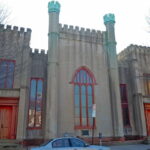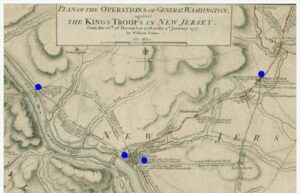St. Michael’s Episcopal Church of Trenton
St. Michael’s was built before the autumn of 1748. The King Street building  was 40 feet square with a gabled roof (triangular sides with a sloping roof), and the pulpit was on the north side of the building. The way the name “St. Michael’s” was chosen is also a bit of a mystery; except the cornerstone was laid on the Feast of St. Michael, and the church name was mentioned in the vestry minutes of 1761.
was 40 feet square with a gabled roof (triangular sides with a sloping roof), and the pulpit was on the north side of the building. The way the name “St. Michael’s” was chosen is also a bit of a mystery; except the cornerstone was laid on the Feast of St. Michael, and the church name was mentioned in the vestry minutes of 1761.
The Revolutionary War spanned roughly 1775 to the early 1780’s, and during that time there were no church services at St. Michael’s. Because the congregation was made up of those loyal to the British Crown, as well as Revolutionaries who favored independence, the vestry passed a resolution on Sunday, July 7, 1776, to close the church indefinitely. The next day the Declaration of Independence was read on the steps of the Trenton Court House.
St. Michael’s saw many different faces of the Revolution. The Continental and British armies occupied the church. The Hessians, the German mercenaries who fought with the British army, used the church as a barracks and stable, and stored their artillery in the churchyard while they occupied Trenton. When George Washington and the Continental Army surprised the Hessians on December 26, 1776, some of the fighting of the Battle of Trenton happened in St. Michael’s churchyard. There was hand-to-hand combat with swords, muskets, and bayonets on church grounds. Later in the war, the church was used by George Washington’s Continental Army as a hospital.
Its present building located at 140 North Warren Street and was renovated in 1810 and 1847–1848. It was listed on the National Register of Historic Places on April 29, 1982.
140 N Warren St, Trenton, NJ 08608

